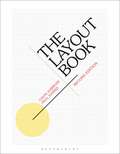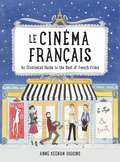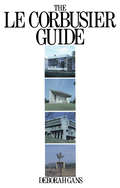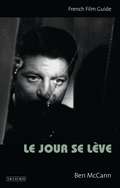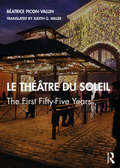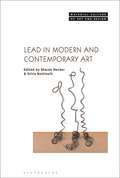- Table View
- List View
The Layout Book (Required Reading Range Ser.)
by Gavin Ambrose Paul HarrisA fascinating exploration of this fundamental aspect of graphic design, The Layout Book explains the hows, whys and why-nots of the placing of elements on a page or screen layout. A historical overview of the subject is followed by a systematic look at key theoretical principles and practical applications.Offering a huge array of potential layout options and with over 200 color illustrations from some of the world's leading design studios, whether you are working in print or digital media this book encompasses a variety of creative approaches. The second edition has also been updated to include interviews with practising designers, as well as new exercises to aid readers in their own explorations.Invaluable for design students looking for a better understanding of layout design, and inspiring for working designers, The Layout Book proves itself as a graphic design must-have.
Layout for Graphic Designers: An Introduction (Basics Design)
by Gavin Ambrose Paul HarrisLayout for graphic design concerns the arrangement of text and images on a page. How these elements are positioned, both in relation to one another, and within the overall design scheme, will affect how content is viewed and received. Whether in print or online, it is key to powerful visual communication. Layout for Graphic Designers provides visual arts students with a theoretical and practical underpinning of this design subject. Packed with over 200 examples from key contemporary practices, and fully illustrated with clear diagrams and inspiring imagery, it offers an essential exploration of the subject. This third edition has been updated to include 25 new images and 6 new case studies from Lundgren + Lindqvist, TwoPoints.Net, Bruce Mau Design, Non-Format, Mind Design and Plau.
Layout for Graphic Designers: An Introduction (Basics Design)
by Gavin Ambrose Paul HarrisLayout for graphic design concerns the arrangement of text and images on a page. How these elements are positioned, both in relation to one another, and within the overall design scheme, will affect how content is viewed and received. Whether in print or online, it is key to powerful visual communication. Layout for Graphic Designers provides visual arts students with a theoretical and practical underpinning of this design subject. Packed with over 200 examples from key contemporary practices, and fully illustrated with clear diagrams and inspiring imagery, it offers an essential exploration of the subject. This third edition has been updated to include 25 new images and 6 new case studies from Lundgren + Lindqvist, TwoPoints.Net, Bruce Mau Design, Non-Format, Mind Design and Plau.
Le Cinema Francais: An Illustrated Guide to the Best of French Films
by Anne Keenan HigginsLe Cinéma Français is an irresistible illustrated guide and primer to the best of French films, starting with the 1950s, through the spectrum of French New Wave, and on to modern-day confections.Starring the likes of Brigitte Bardot, Catherine Deneuve, and Jeanne Moreau, and directed by iconoclasts such as Francois Truffaut, Eric Rohmer, and Jean-Luc Godard, French movies are as touching, beautiful, and romantic as they come in all of film. Le Cinéma Français captures their spirit in whimsical detail. Each movie is covered with a plot summary; back stories; and illustrations by author/artist Anne Keenan Higgins of highlight scenes, costumes, props, and characters that are as enchanting as the films themselves.This gorgeously gifty tribute to French cinema is not just for movie buffs or followers of international films, but for all who are enchanted by French culture.
Le Corbusier - An Analysis of Form
by Geoffrey BakerThis unique appraisal of the famous Swiss architect's major works have now been expanded to include two more buildings. The Villa Shodhan and the Pavilion Suisse round out the coverage of Le Corbusier's significant works. The author critically examines Le Corbusier's achievements helping student and professional alike to appreciate the elements of successful design. The narrative and fine illustration cover the key buildings from each of the four developmental stages of his work, making it an excellent guide for practicing architects and students.
The Le Corbusier Guide
by Deborah GansThe Le Corbusier Guide presents the architecture of Le Corbusier. The focus is on Paris given that it is his adopted city and the place where he came of age. Within its environs is a representative sample of his built work. It contains most of his purist houses, and an early foray away from the crisp surfaces of Purism. This itinerary follows the outlines of Le Corbusier's life's work. Beginning at his birthplace in La Chaux-de-Fonds, Switzerland, the route continues to Paris, to the perimeter of France, and finally to the international scene architects, architecture, Paris. Also presented are Le Corbusier's work in Switzerland, Belgium, Germany, Italy, United States, Argentina, Brazil, Tunisia, Iraq, Japan, USSR, and India. The itinerary includes not only the buildings but also the process of getting from one to the next. On the ""open road"" it is a pleasure to remember Le Corbusier's own joy of self-propulsion in the automobile, efficiency, and speed in the train; and the thrill of flight as he experienced it with the poet of flight, Antoine de Saint Exupery. All these mimetic pleasures are ancillary to the experience of the buildings in situ in their complex relationship to local landscape, national spirit, and international vision.
Le Corbusier in Detail
by Flora SamuelThis is the first book to give such close attention to Le Corbusier's approach to the making of buildings. It illustrates the ways in which Le Corbusier's details were expressive of his overall philosophical intentions. It is not a construction book in the usual sense- rather it focusses on the meaning of detail, on the ways in which detail informs the overall architectural narrative of a building. Well illustrated and containing several specially prepared scaled drawings it acts as timely reminder to both students and architects of the possibilities inherent in the most small scale tectonic gestures.
Le Corbusier in Detail
by Flora SamuelThis is the first book to give such close attention to Le Corbusier's approach to the making of buildings. It illustrates the ways in which Le Corbusier's details were expressive of his overall philosophical intentions. It is not a construction book in the usual sense- rather it focusses on the meaning of detail, on the ways in which detail informs the overall architectural narrative of a building. Well illustrated and containing several specially prepared scaled drawings it acts as timely reminder to both students and architects of the possibilities inherent in the most small scale tectonic gestures.
Le Corbusier's Chandigarh Revisited: Preservation as Future Modernism
by Vikramaditya PrakashWhat is the relevance of the Chandigarh experiment today? Written by an esteemed scholar and former resident of the city, this fascinating book reevaluates Le Corbusier’s work in Chandigarh in terms of the pressing challenges of the present, in particular climate change, globalization, neo-nationalism, and information technology. Through a lively poststructuralist and postcolonial framework, this book explores issues of preservation, identity, meaning, and change, comparing how the Chandigarh we see today compares to the original plans and drawings. But this book also asks whether Chandigarh’s aesthetics, as well as the ethical tenets on which it was based, are still relevant to urban planning and architecture today. What lessons, if any, does the utopian ethos within modernism offer in the face of the climate crisis, rising authoritarianism, and the digital explosion? Via chapters focused on the hydrologics of the master plan, the symbolism of the Capitol buildings, and the archeology of the unbuilt Museum of Knowledge, this book makes the future-preservation case for Chandigarh as an ‘open’ work, a project that was set up by design to be ‘completed’ by others in times yet to come. Engaging and erudite throughout, this book will appeal to any student, scholar, or professional with an interest in architecture, landscape architecture, and urban planning.
Le Corbusier's Chandigarh Revisited: Preservation as Future Modernism
by Vikramaditya PrakashWhat is the relevance of the Chandigarh experiment today? Written by an esteemed scholar and former resident of the city, this fascinating book reevaluates Le Corbusier’s work in Chandigarh in terms of the pressing challenges of the present, in particular climate change, globalization, neo-nationalism, and information technology. Through a lively poststructuralist and postcolonial framework, this book explores issues of preservation, identity, meaning, and change, comparing how the Chandigarh we see today compares to the original plans and drawings. But this book also asks whether Chandigarh’s aesthetics, as well as the ethical tenets on which it was based, are still relevant to urban planning and architecture today. What lessons, if any, does the utopian ethos within modernism offer in the face of the climate crisis, rising authoritarianism, and the digital explosion? Via chapters focused on the hydrologics of the master plan, the symbolism of the Capitol buildings, and the archeology of the unbuilt Museum of Knowledge, this book makes the future-preservation case for Chandigarh as an ‘open’ work, a project that was set up by design to be ‘completed’ by others in times yet to come. Engaging and erudite throughout, this book will appeal to any student, scholar, or professional with an interest in architecture, landscape architecture, and urban planning.
Le Corbusier's Venice Hospital Project: An Investigation into its Structural Formulation (Ashgate Studies in Architecture)
by Mahnaz ShahWhile Le Corbusier's urban projects are generally considered confrontational in their relationship to the traditional urban fabric, his proposal for the Venice hospital project remained an exercise in preserving the medieval fabric of the city of Venice through a systemic replication of its urban tissue. This book offers a detailed study of Le Corbusier's Venice hospital project as a plausible built entity. In addition, it analyses it in the light of its supposed affinity with the medieval urban configuration of the city of Venice. No formal attempt to date has been made to critically analyse the hospital project's design considerations in comparison to the medieval urban configuration of the city of Venice. Using a range of methodologies including those from architectural theory and history, using archival resources, on-site analysis, and interviews with important resource persons, this book is an interpretation of the conceptual basis for Le Corbusier understanding of the structural formulation of the city of Venice as mentioned in The Radiant City (1935). In doing so, it deciphers the diagrammatic analysis of the city structure found in this work into a set of coherent design modules that were applied in the hospital project and that could become a point of further investigation. Architects and other architecturally interested laypeople with an interest in Venice will find the book a valuable addition to their knowledge. For architectural historians the book makes an important link between modernism and the historically grown Venice.
Le Corbusier's Venice Hospital Project: An Investigation into its Structural Formulation (Ashgate Studies in Architecture)
by Mahnaz ShahWhile Le Corbusier's urban projects are generally considered confrontational in their relationship to the traditional urban fabric, his proposal for the Venice hospital project remained an exercise in preserving the medieval fabric of the city of Venice through a systemic replication of its urban tissue. This book offers a detailed study of Le Corbusier's Venice hospital project as a plausible built entity. In addition, it analyses it in the light of its supposed affinity with the medieval urban configuration of the city of Venice. No formal attempt to date has been made to critically analyse the hospital project's design considerations in comparison to the medieval urban configuration of the city of Venice. Using a range of methodologies including those from architectural theory and history, using archival resources, on-site analysis, and interviews with important resource persons, this book is an interpretation of the conceptual basis for Le Corbusier understanding of the structural formulation of the city of Venice as mentioned in The Radiant City (1935). In doing so, it deciphers the diagrammatic analysis of the city structure found in this work into a set of coherent design modules that were applied in the hospital project and that could become a point of further investigation. Architects and other architecturally interested laypeople with an interest in Venice will find the book a valuable addition to their knowledge. For architectural historians the book makes an important link between modernism and the historically grown Venice.
Le Jour se Lève: French Film Guide (Ciné-File French Film Guides)
by Ben McCannLe Jour se leve (1939) directed by Marcel Carnè, is widely recognised as the classic French Poetic Realist film. Told in flashback, it recounts the story of a man who has committed a murder, and who awaits his fate as the police close in. Carnè shuttles between different registers, tones and textures throughout, marshalling the studio's resources to create striking pictorial compositions. The film also contains the great French star Jean Gabin's most iconic performance as Francois, marooned at the top of his apartment building. Ben McCann's perceptive and lively book traces the evolution of Le Jour se leve and situates it in a very specific historical moment. He also underlines the importance of actors Jules Berry and Arletty, production designer Alexandre Trauner, writer Jacques Prevert and cinematographer Curt Courant in establishing the film's tone, mood and visual style. He charts the national and international reception of the film, uncovering a work that deeply divided critics at a time of national crisis. He also reveals Le Jour se leve to be a key transitional work between European and American noir and compares it with the 1947 Hollywood remake.Highlighting its combination of the 'poetic' and the 'realist' this book finally stresses how Le Jour se leve represents the very best of pre-war French studio filmmaking.
Le Poison et le remède: théâtre, morale et rhétorique en France et en Italie 1694-1758 (Oxford University Studies in the Enlightenment #360)
by Sylviane LéoniPoison pour Platon et les pères de l’Eglise, catharsis pour Aristote, le théâtre occidental trouva plus facilement une place dans la vie quotidienne de la cité que dans la réflexion des élites intellectuelles. Pendant plus de deux mille ans, loin des applaudissements et des murmures des spectateurs, se noua ainsi une longue ‘histoire des mots’, solidaire d’une histoire de la pensée car le discours sur le théâtre fut aussi, tout au long des siècles, discours sur l’homme et sa place dans le monde, discours sur la mimesis, sur le savoir et le pouvoir des mots. Au cours de la première moitie du dix-huitième siècle, le débat sur la légitimité des spectacles fait apparaître les permanences, les ruptures, les ambiguïtés d’une époque partagée entre la vérité des théologiens et celle des philosophes, entre un modèle ascétique d’humanité et une aspiration a un solide bonheur terrestre, entre un savoir fonde sur les textes et une raison fille de l’expérience. Contempteur des sciences et des arts, Rousseau ajoute encore à la complexité de ce débat.Si, en Italie, la prudence a l’égard de l’Eglise et des valeurs chrétiennes fut plus grande qu’en France, cette polémique révèle néanmoins, dans les deux pays, un dix-huitième siècle bien-pensant, soucieux de théâtre moral et vertueux, ce que n’attestent pas, on le sait, d’autres textes de la même période. Querelles ou les mots règnent en maîtres, la querelle sur la légitimité du théâtre attire donc également l’attention sur l’opacité que pouvait avoir le document écrit a cette époque: opacité a l’égard des faits, des idées, mais aussi des interrogations étrangères a la culture rhétorique à laquelle il appartenait souvent.
Le Théâtre à Montpellier 1755-1851 (Oxford University Studies in the Enlightenment #2001:02)
by Pierre JourdaCet ouvrage posthume de Pierre Jourda propose une histoire du théâtre de Montpellier de 1755, date de la construction de la première salle, à 1851. La première salle, édifiée par Mareshal, était tenue pour ‘une des plus jolies et des plus commodes’ d’un royaume qui en comptait de plus en plus. La tragédie y trouve son public, le drame aussi, mais la comédie domine: Molière et surtout les auteurs du XVIIIe siècle. On apprécie l’opéra et d’avantage l’opéra-comique: Pergolèse, Rousseau, et tant d’auteurs oubliés aujourd’hui. La presse naissante fait entendre sa voix: respectueuse des valeurs consacrées, mais sans être dupe des formules à la mode. Montpellier fête les grands acteurs qui triomphent à Paris: Lekain, Talma, Mlle Georges, Marie Dorval. Elle goûte le mélodrame plus que le drame romantique; à Weber et Berlioz elle préfère Halévy, Auber, Meyerbeer.La Révolution engendre un public friand d’émotions fortes, de participation patriotique; l’ordre restauré, il continuera d’exprimer ses choix avec véhémence: Montpellier sera une scène redoutable pour les acteurs, surtout dans l’impitoyable rituel des ‘débuts’.Redoutable aussi pour les directeurs du théâtre, confrontés à des contraintes financières qu’aggravent les mises en scènes éxigées par la concurrence de spectacles de tréteaux – et de la campagne languedocienne, lors de l’été. Près de trente changements de directeurs entre 1790 et 1851; s’appuyant sur les documents d’archives et sur la presse locale, Pierre Jourda établit leurs comptes avec une précision éloquente, égrène la litanie de leurs promesses et de leurs illusions, de leurs suppliques auprès de maires et de préfets aussi soucieux de l’orthodoxie du répertoire que de la viabilité de l’entreprise. Montpellier pourrait-elle être encore privée de théâtre? Ce n’est pas exclu: la crise est profonde. La bourgeoisie boude le théâtre. Le public trouve le répertoire monotone , mais les audaces l’effraient: on est au rouet.
Le Théâtre de la Foire: des treteaux aux boulevards (Oxford University Studies in the Enlightenment #2002:10)
by Isabelle MartinLe Théâtre de la Foire, né dans les foires parisiennes de Saint-Germain et de Saint-Laurent, a fait courir tout Paris depuis sa création jusqu’à sa disparition en 1762. Spectacle foisonnant puisque des dizaines d’auteurs en ont constitué le fonds littéraire qui comporte plusieurs centaines de pièces. Il existe d’excellentes études partielles, mais aucune étude d’ensemble n’avait été entreprise sur un sujet où la critique littéraire rencontre le renouvellement des arts du spectacle et l’évolution des mœurs et de la pensée. Il s’agissait donc de combler cette lacune par une synthèse sur le Théâtre de la Foire considéré comme une forme de sociabilité essentielle à la compréhension de l’histoire des idées à une époque donnée, dans le mouvement même des représentations de la vie quotidienne.Si le but apparent de ce théâtre est d’amuser un public par un spectacle original et inventif, ses ambitions sont beaucoup plus vastes. Issu du milieu mercantile des foires, il diffuse des idées de libre entreprise qu’il met lui-même en œuvre, en s’opposant aux privilèges de la Comédie-Française et de l’Opéra. Dans la société d’Ancien Régime où apparaissent des signes de décomposition, il tente de réformer les mœurs et de promouvoir dans la bonne humeur certaines nouvelles idées philosophiques dont une morale bourgeoise et séculière du juste milieu.Face aux salles officielles qu’immobilise leur statut et une scène populaire inconvenante, il élabore une nouvelle forme de théâtralité amalgamant les pratiques des spectacles de rue tels l’acrobatie, les danseurs de corde ou la pantomime avec les traditions du théâtre savant, de l’Opéra et des scènes française et italienne.Sa conception essentiellement baroque, brillante, faussement naïve et populaire semble anticiper les grandes mises en scène actuelles. Le Théâtre de la Foire demeure aujourd’hui le meilleur miroir de la société parisienne du XVIIIe siècle dont la référence essentielle est au-delà du théâtre lui-même la théâtralisation de son quotidien.
Le Théâtre du Soleil: The First Fifty-Five Years
by Béatrice Picon-VallinLe Théâtre du Soleil traces the company’s history from a group of young, barely trained actors, directors, and designers struggling to match their political commitment to a creative strategy, to their grappling with the concerns of migration, separation and exile in the early decades of the twenty-first century. Béatrice Picon-Vallin recounts how, in the 55 years since its founding, the Théâtre du Soleil has established itself as one of the foremost names in modern theatre. Ariane Mnouchkine and her collaborators have developed a unique and ever-evolving style that combines a piercing richness of shape, color, and texture with precision choreography, innovative musical accompaniment, and multi-layered, metaphorical dreamscapes. This rich, storied history is illustrated by a wealth of spectacular rehearsal and production photos from the company's own archive and interviews with dozens of past and present members, including Mnouchkine herself. Judith G. Miller’s timely translation of the first comprehensive history and analysis of a remarkable, award-winning company is a compelling read for both students and teachers of Drama and Theatre Studies.
Le Théâtre du Soleil: The First Fifty-Five Years
by Béatrice Picon-VallinLe Théâtre du Soleil traces the company’s history from a group of young, barely trained actors, directors, and designers struggling to match their political commitment to a creative strategy, to their grappling with the concerns of migration, separation and exile in the early decades of the twenty-first century. Béatrice Picon-Vallin recounts how, in the 55 years since its founding, the Théâtre du Soleil has established itself as one of the foremost names in modern theatre. Ariane Mnouchkine and her collaborators have developed a unique and ever-evolving style that combines a piercing richness of shape, color, and texture with precision choreography, innovative musical accompaniment, and multi-layered, metaphorical dreamscapes. This rich, storied history is illustrated by a wealth of spectacular rehearsal and production photos from the company's own archive and interviews with dozens of past and present members, including Mnouchkine herself. Judith G. Miller’s timely translation of the first comprehensive history and analysis of a remarkable, award-winning company is a compelling read for both students and teachers of Drama and Theatre Studies.
Le Week-end
by Hanif KureishiIn Le Weekend, a couple - married for 30 years - spend their wedding anniversary in Paris. However, the romantic city soon becomes a backdrop to their increasingly bitter disputes about the state of their marriage - and their lives.But, as they gradually become part of the rhythm of the city - its cafes and monuments - the tension that has burdened them fades as they re-discover the playfulness and anarchy of their youth.Their melancholy dissolves in a sense of delight in irresponsibility, and gives them a new lease of life
Lead Designer's Handbook: The Lead Designer and Design Management
by Dale SinclairDespite co-ordination being the principal focus of the Lead Designer’s role, there is very little written about how to undertake these duties. What tools can the Lead Designer use to address the many complexities of developing a design as part of an iterative process? How can the Lead Designer redefine what they do using a digital world to provide profoundly different and new services? This book analyses at all of these questions, setting out how the Lead Designer can perform effectively and efficiently in the digital world, addressing clients’ new whole life project requirements and new ways of constructing and assembling buildings. Managing increasing numbers of specialists in the construction process requires experience to ensure that their contributions are properly managed and produced at the right time. This book considers this challenge. It will also consider how the Lead Designer can effectively lead and manage health and safety aspects and risks (the principal designer role in UK regulations).
Lead Designer's Handbook: The Lead Designer and Design Management
by Dale SinclairDespite co-ordination being the principal focus of the Lead Designer’s role, there is very little written about how to undertake these duties. What tools can the Lead Designer use to address the many complexities of developing a design as part of an iterative process? How can the Lead Designer redefine what they do using a digital world to provide profoundly different and new services? This book analyses at all of these questions, setting out how the Lead Designer can perform effectively and efficiently in the digital world, addressing clients’ new whole life project requirements and new ways of constructing and assembling buildings. Managing increasing numbers of specialists in the construction process requires experience to ensure that their contributions are properly managed and produced at the right time. This book considers this challenge. It will also consider how the Lead Designer can effectively lead and manage health and safety aspects and risks (the principal designer role in UK regulations).
Lead in Glassy Materials in Cultural Heritage
by Anne Bouquillon Patrice LehuédéAlthough the development of lead crystal was a major step in the history of glass in the late 17th century, the presence of lead in vitreous matrices (glass and glazes) is much older, dating back to the second millennium BCE. Lead in Glassy Materials in Cultural Heritage traces the history of these skills and also looks at the most recent developments in materials science concerning the role played by lead in the properties of glass, including coloring. It develops an understanding of weathering processes and notions of the durability of leaded glass. It also examines public health issues and current recommended standards for the use of lead in industrial glass. This multidisciplinary book is intended for a wide audience: art and technical historians, museum curators, restorers, materials specialists, manufacturers and engineers.
Lead in Glassy Materials in Cultural Heritage
by Anne Bouquillon Patrice LehuédéAlthough the development of lead crystal was a major step in the history of glass in the late 17th century, the presence of lead in vitreous matrices (glass and glazes) is much older, dating back to the second millennium BCE. Lead in Glassy Materials in Cultural Heritage traces the history of these skills and also looks at the most recent developments in materials science concerning the role played by lead in the properties of glass, including coloring. It develops an understanding of weathering processes and notions of the durability of leaded glass. It also examines public health issues and current recommended standards for the use of lead in industrial glass. This multidisciplinary book is intended for a wide audience: art and technical historians, museum curators, restorers, materials specialists, manufacturers and engineers.
Lead in Modern and Contemporary Art (Material Culture of Art and Design)
by Sharon Hecker and Silvia BottinelliLead in Modern and Contemporary Art is the first edited volume to critically examine uses of lead as both material and cultural signifier in modern and contemporary art. The book analyzes the work of a diverse group of artists working in Europe, the Middle East, and North America, and takes into account the ways in which gender, race, and class can affect the cultural perception of lead. A distinguished group of international contributors from various fields, both established and early in their careers, explore lead's relevance from a number of perspectives, including art history, technical art history, art criticism and curatorial studies. Drawing on current art historical concerns with materiality, this volume builds on recent exhibitions and scholarship that reconsider the role of materials in shaping artistic meaning, thus giving a central relevance to the object and its physicality.
Lead in Modern and Contemporary Art (Material Culture of Art and Design)
Lead in Modern and Contemporary Art is the first edited volume to critically examine uses of lead as both material and cultural signifier in modern and contemporary art. The book analyzes the work of a diverse group of artists working in Europe, the Middle East, and North America, and takes into account the ways in which gender, race, and class can affect the cultural perception of lead. A distinguished group of international contributors from various fields, both established and early in their careers, explore lead's relevance from a number of perspectives, including art history, technical art history, art criticism and curatorial studies. Drawing on current art historical concerns with materiality, this volume builds on recent exhibitions and scholarship that reconsider the role of materials in shaping artistic meaning, thus giving a central relevance to the object and its physicality.
